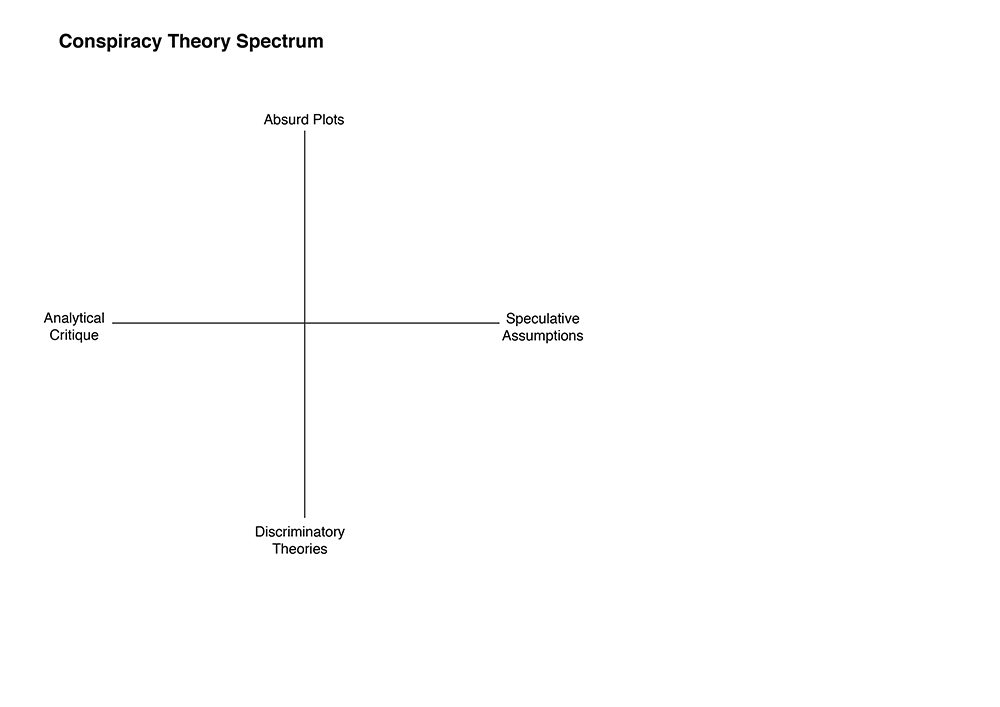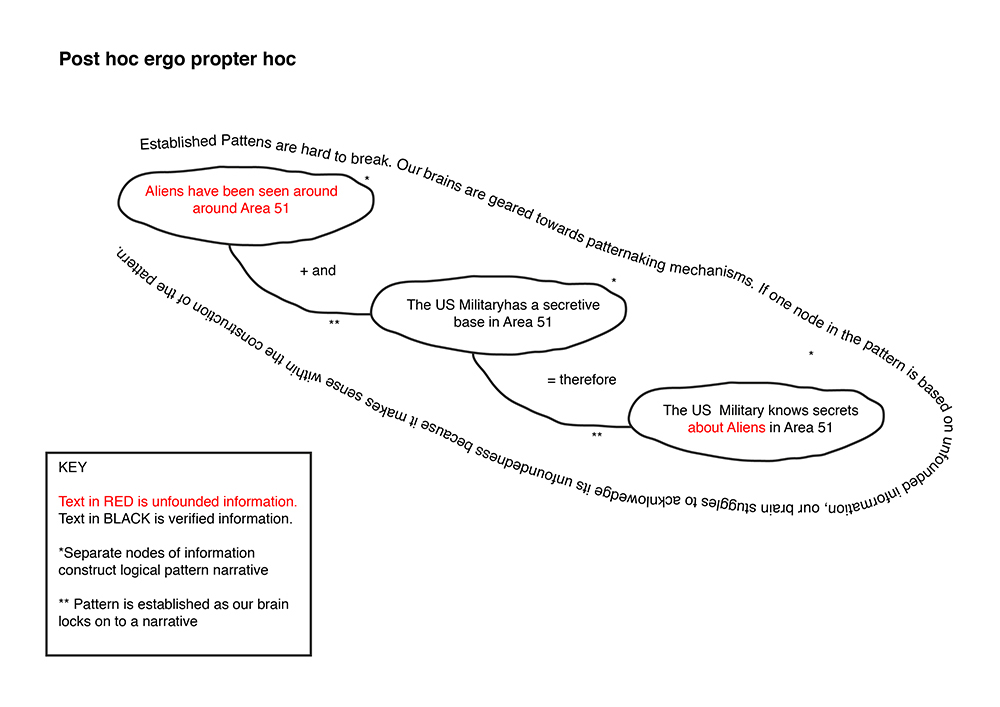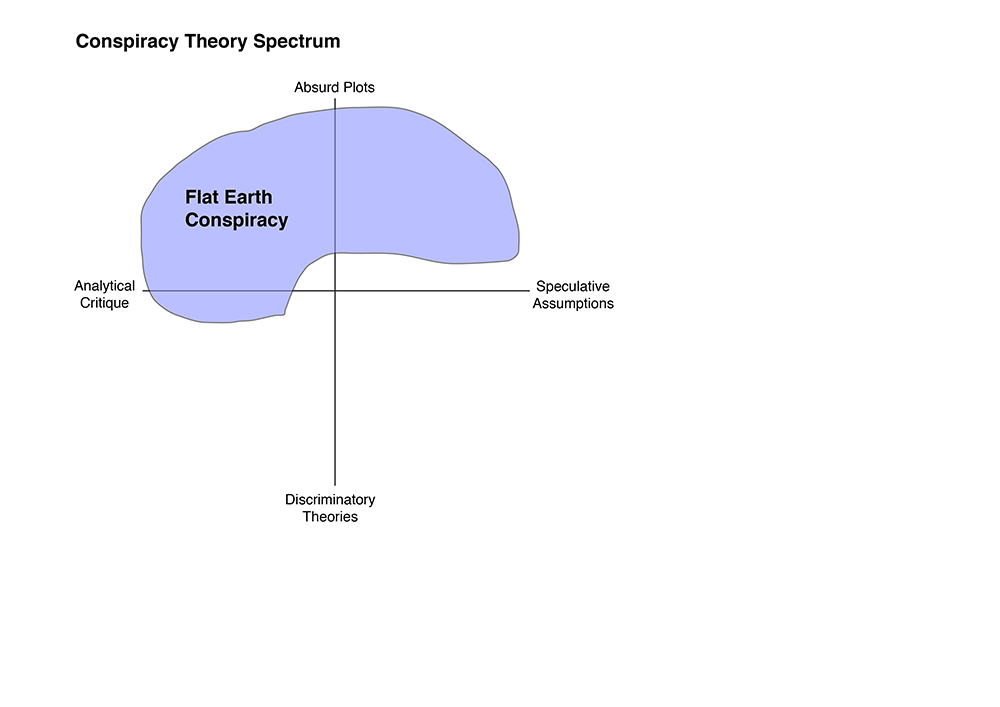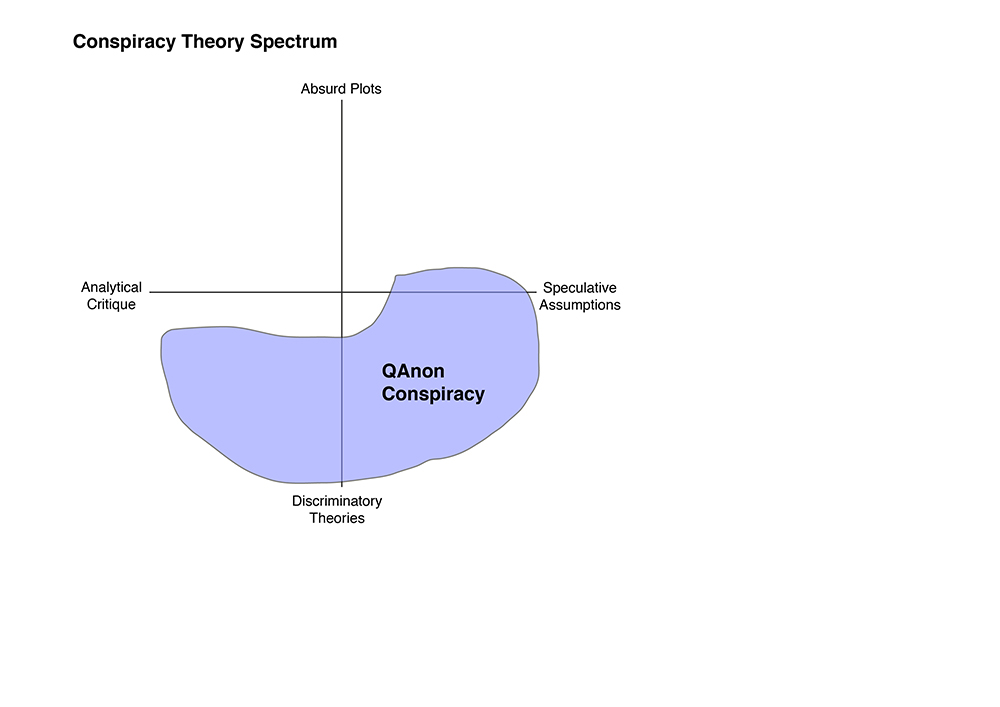Conspiring to Curate Conspiracies
By Tiiu Meiner
Truths manifest in many different intensities and magnitudes. They fluctuate, in form and structure, to fit the relativity of the discourse. Taking on the role of justices or weapons, truths can morph, explode, disappear and hide. They exist within us, and without us.
Conspiracy theories are potential truths. They rely on a ‘coherent’ logic to connect points in arguments, creating highly convincing and comprehensible narratives. They are also speculative and conspiratorial, often unproven or partially so. This inspires strong emotional reactions, such as fear or repulsion, amongst the exposed public.
Truths also exist on a spectrum of danger, stretching far and wide to address various topics and structures. The nature of a conspiracy theory—whether it is absurd, analytical, speculative or discriminatory—determines its placement in the spectrum of danger. An analytical critique of society is considered low risk, for instance, along with speculative assumptions. Absurd plots bordering on science-fiction make a conspiracy seem ridiculous, steering it away from danger.
However, discriminatory theories questioning the legitimacy of historical events and targeting racial groups are classified as dangerous misinformation. Even though conspiracy theories differ in content and the degree of risk, they always exist on the spectrum of danger:

Since all conspiracies are a potential threat, and we must also discuss them as cultural objects, then we must grapple with the dilemma of giving them a platform, which risks spreading or strengthening their fallacy. Thus, we face a problem in museum practices—for how can we collect, archive and display conspiracy theories for the museum-going public.
Collection and Curation:
The internet is a thriving ground for conspiracy theories, and its hyper connectivity makes it the ideal stage for disseminating and multiplying the conspiratorial ‘truths’ previously relegated to the fringes of society. Social media channels, such as Twitter, TikTok, Facebook and YouTube, have attempted to slow the proliferation of conspiracies by blocking accounts and conspiracy content on their platforms. But the nature of the conspiracy theory is that it can morph and reappear under different guises, even if it is banned.
It is clear that conspiracy theories are culturally relevant, however, their fragmentation and elusiveness across multiple platforms makes them difficult to identify and categorise. They are evasive digital artefacts—unlike traditional physical objects, which can be understood through an explicit tangibility.
The curatorial project ‘Content Data Object’, by Victoria & Albert Museum, London, grapples with the question of how to collect digital objects. The main argument for the project’s collection methodology is that, although digital content is not always physically felt, it must still be considered a material, and not just something ephemeral or abstract. As Juhee Park and Anouska Samms explain:
Because materiality depends on relational processes, digital objects cannot be mistaken for isolated, singular objects. We can imagine a future where the iPhone 6 may not be able to connect to the current environment of a digital ecosystem, for instance, when it is no longer possible to access certain mobile applications or specific digital media platforms, perhaps because the companies and developers may have decided to stop maintaining them, rendering them obsolete.
This state of perpetual obsolescence is a blessing and a curse for collectors of conspiracy theories. On the one hand, we can collect individual digital artefacts, to analyse and exhibit separately, without sharing the full narrative of the conspiracy (contributing to their spread). On the other, this lack of agreement on how to collect conspiracy theories, in relation to their context, means we may miss them entirely. This impacts the capacity of a future generation to understand the relevance of conspiracy theories in our present day.
Park and Samms respond to this lack of consensus in the curatorial field with a collection methodology premised on four concepts of digital materiality: the forensic, formal, distributed and performative. Forensic and formal refer to hardware and software (through which the digital manifests), while distribution and performativity expand on intangible matter, considering the functional meaning of digital objects beyond their physicality. The distribution and performativity methods contextualise and analyse a digital object as an artefact by looking at what it does, rather than its material properties. This creates an important link for online conspiracy theory content and the offline tangible world, because classifying them solely as abstract (and subsequently ignoring their objecthood), fails to consider their significance as networked belief systems or hold conspiracy theorists accountable in their roles as political influencers.
Online conspiracy theories are mainly networked on social media accounts, groups, and chat rooms. One identifiable medium in conspiratorial communication is ‘bad quality’ memes and infographics. For example, the QAnon conspiracy is mostly spread on the ‘politically incorrect’ image board website 4Chan. QAnon believers allege that Donald J. Trump is a vigilante hero, fighting to unveil and stop an alleged child-trafficking sex ring embedded in elite celebrity and Democrat networks, which, according to the theory, has also infiltrated world politics. Whether created and disseminated with malicious intent or poor judgement, the QAnon conspiracy began in 2017, when the theory was circulated amongst fringe groups on 4Chan (in response to the cryptic messages being posted by an account named Q, which purported to have insider-access to the US Government).
Thus the relationship between conspiratorial belief systems and image circulation online becomes critical to understand. Hito Steyerl explains the potentiality between image, which she calls ‘poor images’, and their political effect ‘is about its own real conditions of existence: about swarm circulation, digital dispersion, fractured and flexible temporalities. It is about defiance and appropriation just as it is about conformism and exploitation.’ The conspiratorial images circulating in 4Chan demonstrate this principle of defiance, as they seek to find value in amateurish, disregarded, taken-for-granted, overly handled and intensively traversed images.
This outsider status resonates with conspiracy theorists, as their message of anti-establishment, anti-elite and anti-corruption calls for a re-evaluation of what we consider the norm, or what is acceptable. Steyerl’s point of swarm circulation, defiance and appropriation also accounts for the use of low grade imagery in conspiracy theories, because the poor image aesthetic is an aesthetic of validation. That is, the narrative of an amateur ‘truth seeker’, existing on the outskirts of society, able to see ‘clearly’, is the revered protagonist of most, if not all, conspiracy theory movements.
Referring back to the idea of exhibiting individual artefacts, without spreading a whole conspiracy narrative, the poor image is key in understanding and curating conspiracy theories. Although impossible to trace and ubiquitous in its examples, the poor image can be dissected for clues of origin and intention. Hectic scribblings, all caps text, pixelated quality, and cliche images. These are all commonly understood visual languages of conspiracy theorists, which reiterate the idea of an amateur underdog fighting against the polished elites of society.
However, this visual language also makes researching, understanding and curating conspiracies very hard to navigate. We can pinpoint certain elements as building blocks of online conspiracy theories, and yet, due to their fractious and interactive quality, there is no clear way to showcase a whole network of conspiracy theories as they are shared, refined and developed by separate individuals. As Park and Samms suggest, ‘the distributed or ‘networked’ nature of digital objects operates through servers, at different speeds and within diverse environments—the ways in which the digital object spreads, extends and engages is, in theory, endless. Therefore, the way the digital object is experienced and re-designed through its application by users is also, in theory, endless.’ Due to the conspiracy’s continuous nature, it becomes evident that we should focus on exhibiting the how of conspiracy theories, rather than the what—which is never ending.
Exchanges in message boards and chatrooms are one example of the how, as they are an important part of conspiratorial communication. Conspiracy theorists use identifiable rhetorical devices in intense chat rooms and groups (Reddit, Facebook, Twitter), namely the Post hoc ergo propter hoc (meaning ‘Since event Y followed event X, event Y must have been caused by event X.’). This is a seductive narrative construct that creates causality by linking unintentional events in a sequence that lacks true consequence. This is exemplified in the construction of QAnon’s narrative: because the QAnon sex ring theory arose just before Trump’s election (event X), his campaign and win (event Y) is attributed to his role as a Republican, who battles corrupt evil deviants (event X must have been caused by event Y).
But this logic fails to consider the wider and more complex reasons for events, and instead connects incorrect information with causalities. Because human brains have evolved to depend on pattern recognition as a form of survival, it is possible to fall for these kinds of narratives while ignoring their shortcomings. The risk of collecting and exhibiting a whole chatroom is the potential for radicalising viewers, seeing as the pattern could indoctrinate audiences. Therefore, by mainly exhibiting the construction of such phrases, rather than their content, we could exemplify the how of conspiracies by providing thorough linguistic context, typifying their construction and effect.

Curating conspiracy theories + polarising audiences:
Having established that online conspiracy theories are digital objects with cultural value, existing within a spectrum of danger, we may consider how to curate and communicate their content to the public. By only alluding to some of their limited features, the above examples fail to explain the whole existence of conspiracy theories, or the experience of them as belief systems. Therefore, it is helpful to explore how a conspiracy comes into existence in the first place.
The ‘Digital Dilemmas: The Architecture of Trust’ exhibition, at Bureau Europa in 2019, offered a contextualised and historical narrative of conspiracies. This particular exhibition included, amongst other things, artist works about conspiracy theories. In the exhibition, the main hallway was turned into a time-line about the historical prevalence of the Flat Earth conspiracy theory.
One of the curatorial aims of ‘Digital Dilemmas’ was to historically contextualise the Flat Earth theory as a movement entangled in a religious past, warped by misreadings of maps, and fractured internet informatics—giving audiences a thorough understanding of why such a belief exists. The exhibition tactfully unveiled discrepancies in the form of a linear historical narrative, rather than counter-stating and creating a dualist atmosphere of right and wrong. The visitor was trusted to make up their own mind.

In many ways, the ‘Flat Earth theory’ can be understood as a ‘tip-of-the-iceberg’ fundamental conspiracy, due to its absolute contradiction against mainstream and established knowledge institutions. By denying the very shape of the planet upon which our current society is built, it positions itself in resounding opposition to institutional knowledge.
Proposing a method based on how, not what:
It’s important to draw attention to the fact that the ‘Digital Dilemmas’ exhibition only addressed the informational narrative of the Flat Earth conspiracy theory. Such an approach supports the misconception that conspiracy theories are just harmless thoughts that exist outside of our everyday lives. Although it may be informative to understand how such a theory came about for those who do not believe the theory, it can also have an inflammatory effect on those who are on the fence about believing it. Instead, I am proposing that we must carefully consider our approach to a conspiracy theory, in order to understand how it works rather than what information it is peddling. To do so allows us to investigate the ways in which conspiracy theories do infiltrate and impact on our daily lives. Additionally, we must always express that they are inherently dangerous theories, and, therefore, a problematic belief system to follow.

In 2016, the shooting at Comet Ping Pong pizza restaurant proved the serious and tragic threat that conspiracy theories can have. Dubbed #Pizzagate, the violent event is now considered a predecessor to the QAnon group, with alt-right sites (as well as 4Chan, 8Chan and Twitter accounts) convincing the shooter that the Comet Ping Pong restaurant was running an elite child sex ring on its premises. This is a most tragic example of how online conspiracies infiltrate the ‘offline’ world with real-life consequences. It is the increasing normalisation of extremist conspiracies, and their acceptance by mainstream institutions, that perpetuates this real-life risk. Today, with eleven US Republican congressional candidates currently linked to QAnon in America, and twenty-four running for election, we can observe how fringe beliefs are validated and then given a platform to influence political decisions and policy-making. It also brings legitimacy to these conspiratorial beliefs.
When asked whether QAnon has a place amongst Republican voters, Peter Feaman, a Republican National Committeeman of Florida, responded:
Everybody who’s concerned about the corruption in Washington D.C. (some of that includes people who follow Q), absolutely. QAnon is slowly revealing things about the deep state and the swamp that people need to know. And so, President Trump embraces that in some respect because he’s there to drain the swamp as well….Q is a people’s movement and whether it has a place in the Republican party formally or not, is not really the issue. Q is important, because questions are being raised about the deep state.
By validating QAnon as a reasonable concern, Feaman is essentially supporting the collapse of fact and fiction. Internet research by everyday individuals, without any guidance or standardised research methodologies is fair game. However, the ability to differentiate between reality and paranoia is essential to a coherent society. Navigating the ethics of trustworthy information requires support and education, so an exhibition that generates discussion, or access to archival research, is an important resource.
The fluid data landscape of conspiracy theories is overwhelming, for the theories have a never-ending quality: conspirators can always develop, rebut and rethink them. This makes the theories uniquely eternal, as they feed on the ubiquity of online information. Mainstream institutions, thus, are constantly fighting to keep up with their proliferation, through reflection, reconsideration and projection. It is crucial for curators to focus on how to depict this experiential component of conspiracy theory landscapes, rather than working on what to depict, considering the latter is always changing. Instead of focusing on depicting conspiracies as narrative objects, made of information fragments, we should regard them as contextual architectures of performative and experiential culture, with the potential to affect our social well being.